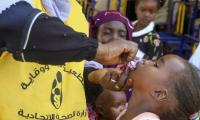KARACHI: A highly enlightening and informative exhibition on the refugee phenomenon opened at the Commune Artist Colony on Saturday afternoon. The exhibition titled ‘Arrival City’ was held under the joint auspices of the Goethe-Institut and Marvi Mazhar & Associates.
The pictorial exhibition traces the phenomenon and the circumstances that cause the influx of refugees, the pushes and pulls that cause conflicting feelings among them as regards their identity and cultural heritage, their welcome by the host societies, the differences about their identity that arise between them and their future generations, their economic opportunities, and the availability of urban spaces to them.
The exhibition had as its theme the presence of Afghan refugees in the country who flooded Pakistan after the Soviet entry there towards the fag end of the 1970s decade, something audaciously referred to by the West as the “Soviet invasion”, little realising (or knowing) that the Soviet troops came after the joint decision of the Afghan government, headed by Hafeezullah Amin, and the Soviets under Article 4 of the Afghan-Soviet Friendship Treaty of 1921.
There were transparencies and videos of the Afghan settlements spread out all over Karachi. The videos showed interviews and profiles of various Afghans in town and the conflicting feelings they had about their stay in Pakistan which, for all practical purposes, has assumed a permanent nature.
Despite having stayed here for decades now, many are shown pining for their homeland and dream of returning, while others recount the problems they come across in an alien environment. There are still others who seem content to have reconciled themselves in a new home and a new environment.
This is precisely what Peter Cachola Schmal, director of the German Museum of Architecture in Frankfurt, Germany, had to comment while talking to The News.
He said that there were cases where immigrants had come from the same country but from different places within the same country, while there were other cases where immigrants had come from the same village, like the Bangladeshi diaspora in Southall, London. He added that they are helped into settling down economically by the kindred feeling of their fellow immigrants.
The immigrants may have resolutely decided to return to their country of origin, but their second generation, who has been born and bred in that alien set-up, assimilate the features of the host society, while the third generation may not even think of returning, as the land of their forefathers has become totally foreign to them.
He agreed that tensions between these immigrants and the host society did occur, and said that while nobody expected the immigrants to give up their cultural mores, it was also incumbent on the immigrants to assimilate in that society by taking up the host societies’ ways.
Speaking of the racial phenomenon, he said that over due course of time, immigrants could easily become fully assimilated in the host society, and cited his own example, saying that while his father was German, his mother was Filipino.
There were photographs depicting the rebirth of the German city of Frankfurt after the Second World War, and how the city was planned and rebuilt to accommodate the immigrants who were flooding it from war-torn Europe. Earlier, Marvi Mazhar of Marvi Mazhar & Associates welcomed the guests and talked of the relevance of the exhibition, followed by Stephen Winkler, director of the Goethe-Institut, Peter Cachola Schmal and Yousuf Bashir.
Session of National Assembly on April 7th will be the 15th session of Sixteenth National Assembly
FEC member Shafiq Awan announced that consultations for an intensified protest strategy were ongoing
Film features stellar cast, including Samina Peerzada, Javed Sheikh, Faysal Quraishi, Sonya Hussyn, Bushra Ansari
Under new amendment, PM will be able to delegate duties as in-charge minister to ministers of state and advisers
Ali Tahir has been appointed at the Federal Ombudsman Secretariat
Delegation requested BNP leaders to end their protest and disperse peacefully







